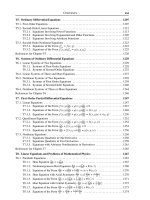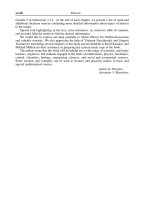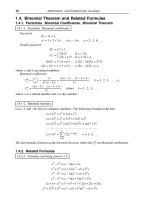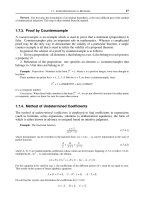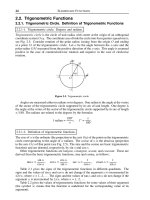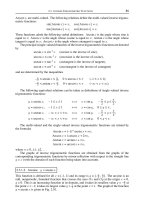Handbook of mathematics for engineers and scienteists part 176 pdf
Bạn đang xem bản rút gọn của tài liệu. Xem và tải ngay bản đầy đủ của tài liệu tại đây (420.65 KB, 7 trang )
T3.6. TABLES OF INVERSE MELLIN TRANSFORMS 1193
No. Direct transform,
ˆ
f(s) Inverse transform, f(x)=
1
2πi
σ+i∞
σ–i∞
ˆ
f(s)x
–s
ds
11
cos
s
2
/a
, a > 0
1
2
a
π
cos
1
4
a|ln x|
2
–
1
4
π
12
arctan
a
s + b
,Res >–b
⎧
⎨
⎩
x
b
|ln x|
sin
a|ln x|
if 0 < x < 1,
0 if 1 < x
T3.6.4. Expressions with Special Functions
No. Direct transform,
ˆ
f(s) Inverse transform, f(x)=
1
2πi
σ+i∞
σ–i∞
ˆ
f(s)x
–s
ds
1 Γ(s), Re s > 0 e
–x
2 Γ(s), –1 <Res < 0 e
–x
– 1
3
sin
1
2
πs
Γ(s), –1 <Res < 1
sin x
4
sin(as)Γ(s),
Re s >–1, |a| <
π
2
exp(–x cos a)sin(x sin a)
5
cos
1
2
πs
Γ(s), 0 <Res < 1
cos x
6
cos
1
2
πs
Γ(s), –2 <Res < 0
– 2 sin
2
(x/2)
7
cos(as)Γ(s), Re s > 0, |a| <
π
2
exp(–x cos a)cos(x sin a)
8
Γ(s)
cos(πs)
, 0 <Res <
1
2
e
x
erfc
√
x
9
Γ(a + s)Γ(b – s),
–a <Res < b, a + b > 0
Γ(a + b)x
a
(x + 1)
–a–b
10
Γ(a + s)Γ(b + s),
Re s >–a,–b
2x
(a+b)/2
K
a–b
2
√
x
11
Γ(s)
Γ(s + ν)
,Res > 0, ν > 0
(1 – x)
ν–1
Γ(ν)
if 0 < x < 1,
0 if 1 < x
12
Γ(1 – ν – s)
Γ(1 – s)
,
Re s < 1 – ν, ν > 0
0 if 0 < x < 1,
(x – 1)
ν–1
Γ(ν)
if 1 < x
13
Γ(s)
Γ(ν – s + 1)
,
0 <Res <
ν
2
+
3
4
x
–ν/2
J
ν
2
√
x
14
Γ(s + ν)Γ(s – ν)
Γ(s + 1/2)
,Res > |ν|
π
–1/2
e
–x/2
K
ν
(x/2)
15
Γ(s + ν)Γ(1/2 – s)
Γ(1 + ν – s)
,
–ν <Res <
1
2
π
1/2
e
–x/2
I
ν
(x/2)
16
ψ(s + a)–ψ(s + b),
Re s >–a,–b
x
b
– x
a
1 – x
if 0 < x < 1,
0 if 1 < x
17 Γ(s)ψ(s), Re s > 0 e
–x
ln x
18 Γ(s, a), a > 0
0 if 0 < x < a,
e
–x
if a < x
19 Γ(s)Γ(1 – s, a), Re s > 0, a > 0
(x + 1)
–1
e
–a(x+1)
1194 INTEGRAL TRANSFORMS
No. Direct transform,
ˆ
f(s) Inverse transform, f(x)=
1
2πi
σ+i∞
σ–i∞
ˆ
f(s)x
–s
ds
20 γ(s, a), Re s > 0, a > 0
e
–x
if 0 < x < a,
0 if a < x
21
J
0
a
√
b
2
– s
2
, a > 0
⎧
⎪
⎨
⎪
⎩
0 if 0 < x < e
–a
,
cos
b
√
a
2
–ln
2
x
π
√
a
2
–ln
2
x
if e
–a
< x < e
a
,
0 if e
a
< x
22
s
–1
I
0
(s), Re s > 0
1 if 0 < x < e
–1
,
π
–1
arccos(ln x)ife
–1
< x < e,
0 if e < x
23 I
ν
(s), Re s > 0
⎧
⎪
⎪
⎪
⎪
⎨
⎪
⎪
⎪
⎪
⎩
–
2
ν
sin(πν)
πF(x)
√
ln
2
x – 1
if 0 < x < e
–1
,
cos
ν arccos(ln x)
π
√
1 –ln
2
x
if e
–1
< x < e,
0 if e < x,
where F (x)=
√
–1 –lnx +
√
1 –lnx
2ν
24
s
–1
I
ν
(s), Re s > 0
⎧
⎪
⎪
⎪
⎨
⎪
⎪
⎪
⎩
2
ν
sin(πν)
πνF (x)
if 0 < x < e
–1
,
sin
ν arccos(ln x)
πν
if e
–1
< x < e,
0 if e < x,
where F (x)=
√
–1 –lnx +
√
1 –lnx
2ν
25
s
–ν
I
ν
(s), Re s >–
1
2
⎧
⎪
⎨
⎪
⎩
0 if 0 < x < e
–1
,
(1 –ln
2
x)
ν–1/2
√
π 2
ν
Γ(ν + 1/2)
if e
–1
< x < e,
0 if e < x
26
s
–1
K
0
(s), Re s > 0
arccosh(– ln x)if0 < x < e
–1
,
0 if e
–1
< x
27
s
–1
K
1
(s), Re s > 0
√
ln
2
x – 1 if 0 < x < e
–1
,
0 if e
–1
< x
28 K
ν
(s), Re s > 0
⎧
⎨
⎩
cosh
ν arccosh(– ln x)
√
ln
2
x – 1
if 0 < x < e
–1
,
0 if e
–1
< x
29
s
–1
K
ν
(s), Re s > 0
1
ν
sinh
ν arccosh(– ln x)
if 0 < x < e
–1
,
0 if e
–1
< x
30
s
–ν
K
ν
(s), Re s > 0, ν >–
1
2
⎧
⎨
⎩
√
π (ln
2
x – 1)
ν–1/2
2
ν
Γ(ν + 1/2)
if 0 < x < e
–1
,
0 if e
–1
< x
References for Chapter T3
Bateman, H. and Erd
´
elyi, A., Tables of Integral Transforms. Vol. 1, McGraw-Hill, New York, 1954.
Bateman, H. and Erd
´
elyi, A., Tables of Integral Transforms. Vol. 2, McGraw-Hill, New York, 1954.
Ditkin, V. A. and Prudnikov, A. P., Integral Transforms and Operational Calculus, Pergamon Press, New
York, 1965.
Oberhettinger, F., Tables of Fourier Transforms and Fourier Transforms of Distributions, Springer-Verlag,
Berlin, 1980.
Oberhettinger, F., Tables of Mellin Transforms, Springer-Verlag, New York, 1974.
Oberhettinger, F. and Badii, L., Tables of Laplace Transforms, Springer-Verlag, New York, 1973.
Prudnikov,A.P.,Brychkov,Yu.A.,andMarichev,O.I.,Integrals and Series, Vol. 4, Direct Laplace
Transforms, Gordon & Breach, New York, 1992.
Prudnikov, A. P., Brychkov, Yu. A., and Marichev, O. I., Integrals and Series, Vol. 5, Inverse Laplace
Transforms, Gordon & Breach, New York, 1992.
Chapter T4
Orthogonal Curvilinear
Systems of Coordinate
T4.1. Arbitrary Curvilinear Coordinate Systems
T4.1.1. General Nonorthogonal Curvilinear Coordinates
T4.1.1-1. Metric tensor. Arc length and volume elements in curvilinear coordinates.
The curvilinear coordinates x
1
, x
2
, x
3
are defined as functions of the rectangular Cartesian
coordinates x, y, z:
x
1
= x
1
(x, y, z), x
2
= x
2
(x, y, z), x
3
= x
3
(x, y, z).
Using these formulas, one can express x, y, z in terms of the curvilinear coordinates
x
1
, x
2
, x
3
as follows:
x = x(x
1
, x
2
, x
3
), y = y(x
1
, x
2
, x
3
), z = z(x
1
, x
2
, x
3
).
The metric tensor components g
ij
are determined by the formulas
g
ij
(x
1
, x
2
, x
3
)=
∂x
∂x
i
∂x
∂x
j
+
∂y
∂x
i
∂y
∂x
j
+
∂z
∂x
i
∂z
∂x
j
;
g
ij
(x
1
, x
2
, x
3
)=g
ji
(x
1
, x
2
, x
3
); i, j = 1, 2, 3.
The arc length dl between close points (x, y, z) ≡ (x
1
, x
2
, x
3
)and(x + dx, y + dy, z + dz) ≡
(x
1
+ dx
1
, x
2
+ dx
2
, x
3
+ dx
3
) is expressed as
(dl)
2
=(dx)
2
+(dy)
2
+(dz)
2
=
3
i=1
3
j=1
g
ij
(x
1
, x
2
, x
3
) dx
i
dx
j
.
The volume of the elementary parallelepiped with vertices at the eight points (x
1
, x
2
, x
3
),
(x
1
+dx
1
, x
2
, x
3
), (x
1
, x
2
+dx
2
, x
3
), (x
1
, x
2
, x
3
+dx
3
), (x
1
+dx
1
, x
2
+dx
2
, x
3
), (x
1
+dx
1
,
x
2
, x
3
+ dx
3
), (x
1
, x
2
+ dx
2
, x
3
+ dx
3
), (x
1
+ dx
1
, x
2
+ dx
2
, x
3
+ dx
3
)isgivenby
dV =
∂(x, y, z)
∂(x
1
, x
2
, x
3
)
dx
1
dx
2
dx
3
=
det |g
ij
| dx
1
dx
2
dx
3
.
Here, the plus sign corresponds to the standard situation where the tangent vectors to
the coordinate lines x
1
, x
2
, x
3
, pointing toward the direction of growth of the respective
coordinate, form aright-handed triple, just asunit vectors
i,
j,
k ofa right-handed rectangular
Cartesian coordinate system.
1195
1196 ORTHOGONAL CURVILINEAR SYSTEMS OF COORDINATE
T4.1.1-2. Vector components in Cartesian and curvilinear coordinate systems.
The unit vectors
i,
j,
k of a rectangular Cartesian coordinate system* x, y, z and the unit
vectors
i
1
,
i
2
,
i
3
of a curvilinear coordinate system x
1
, x
2
, x
3
are connected by the linear
relations
i
n
=
1
√
g
nn
∂x
∂x
n
i +
∂y
∂x
n
j +
∂z
∂x
n
k
, n = 1, 2, 3;
i =
√
g
11
∂x
1
∂x
i
1
+
√
g
22
∂x
2
∂x
i
2
+
√
g
33
∂x
3
∂x
i
3
;
j =
√
g
11
∂x
1
∂y
i
1
+
√
g
22
∂x
2
∂y
i
2
+
√
g
33
∂x
3
∂y
i
3
;
k =
√
g
11
∂x
1
∂z
i
1
+
√
g
22
∂x
2
∂z
i
2
+
√
g
33
∂x
3
∂z
i
3
.
In the general case, the vectors
i
1
,
i
2
,
i
3
are not orthogonal and change their direction from
point to point.
The components v
x
, v
y
, v
z
of a vector v in a rectangular Cartesian coordinate system
x, y, z and the components v
1
, v
2
, v
3
of the same vector in a curvilinear coordinate system
x
1
, x
2
, x
3
are related by
v = v
x
i + v
y
j + v
z
k = v
1
i
1
+ v
2
i
2
+ v
3
i
3
,
v
n
=
√
g
nn
∂x
n
∂x
v
x
+
∂x
n
∂y
v
y
+
∂x
n
∂z
v
z
, n = 1, 2, 3;
v
x
=
∂x
∂x
1
v
1
√
g
11
+
∂x
∂x
2
v
2
√
g
22
+
∂x
∂x
3
v
3
√
g
33
;
v
y
=
∂y
∂x
1
v
1
√
g
11
+
∂y
∂x
2
v
2
√
g
22
+
∂y
∂x
3
v
3
√
g
33
;
v
z
=
∂z
∂x
1
v
1
√
g
11
+
∂z
∂x
2
v
2
√
g
22
+
∂z
∂x
3
v
3
√
g
33
.
T4.1.2. General Orthogonal Curvilinear Coordinates
T4.1.2-1. Orthogonal coordinates. Length, area, and volume elements.
A system of coordinates is orthogonal if
g
ij
(x
1
, x
2
, x
3
)=0 for i ≠ j.
In this case the third invariant of the metric tensor is given by
g =det|g
ij
| = g
11
g
22
g
33
.
The Lam
´
ecoefficients L
k
of orthogonal curvilinear coordinates are expressed in terms
of the components of the metric tensor as
L
i
=
√
g
ii
=
∂x
∂x
i
2
+
∂y
∂x
i
2
+
∂z
∂x
i
2
, i = 1, 2, 3.
* Here and henceforth the coordinate axes and the respective coordinates of points in space are denoted by
the same letters.
T4.1. ARBITRARY CURVILINEAR COORDINATE SYSTEMS 1197
Arc length element:
dl =
(L
1
dx
1
)
2
+(L
2
dx
2
)
2
+(L
3
dx
3
)
2
=
g
11
(dx
1
)
2
+ g
22
(dx
2
)
2
+ g
33
(dx
3
)
2
.
The area elements ds
i
of the respective coordinate surfaces x
i
= const are given by
ds
1
= dl
2
dl
3
= L
2
L
3
dx
2
dx
3
=
√
g
22
g
33
dx
2
dx
3
,
ds
2
= dl
1
dl
3
= L
1
L
3
dx
1
dx
3
=
√
g
11
g
33
dx
1
dx
3
,
ds
3
= dl
1
dl
2
= L
1
L
2
dx
1
dx
2
=
√
g
11
g
22
dx
1
dx
2
.
Volume element:
dV = L
1
L
2
L
3
dx
1
dx
2
dx
3
=
√
g
11
g
22
g
33
dx
1
dx
2
dx
3
.
T4.1.2-2. Basic differential relations in orthogonal curvilinear coordinates.
In what follows, we present the basic differential operators in the orthogonal curvilinear
coordinates x
1
, x
2
, x
3
. The corresponding unit vectors are denoted by
i
1
,
i
2
,
i
3
.
The gradient of a scalar f is expressed as
grad f ≡∇f =
1
√
g
11
∂f
∂x
1
i
1
+
1
√
g
22
∂f
∂x
2
i
2
+
1
√
g
33
∂f
∂x
3
i
3
.
Divergence of a vector v =
i
1
v
1
+
i
2
v
2
+
i
3
v
3
:
divv ≡∇⋅v =
1
√
g
∂
∂x
1
v
1
g
g
11
+
∂
∂x
2
v
2
g
g
22
+
∂
∂x
3
v
3
g
g
33
.
Gradient of a scalar f along a vector v:
(v ⋅∇)f =
v
1
√
g
11
∂f
∂x
1
+
v
2
√
g
22
∂f
∂x
2
+
v
3
√
g
33
∂f
∂x
3
.
Gradient of a vector w along a vector v:
(v ⋅∇)w =
i
1
(v ⋅∇)w
1
+
i
2
(v ⋅∇)w
2
+
i
3
(v ⋅∇)w
3
.
Curl of a vector v:
curlv ≡∇× v =
i
1
√
g
11
√
g
∂
∂x
2
v
3
√
g
33
–
∂
∂x
3
v
2
√
g
22
+
i
2
√
g
22
√
g
∂
∂x
3
v
1
√
g
11
–
∂
∂x
1
v
3
√
g
33
+
i
3
√
g
33
√
g
∂
∂x
1
v
2
√
g
22
–
∂
∂x
2
v
1
√
g
11
.
Remark. Sometimes curlv is denoted by rotv.
Laplace operator of a scalar f :
Δf ≡∇
2
f =
1
√
g
∂
∂x
1
√
g
g
11
∂f
∂x
1
+
∂
∂x
2
√
g
g
22
∂f
∂x
2
+
∂
∂x
3
√
g
g
33
∂f
∂x
3
.
1198 ORTHOGONAL CURVILINEAR SYSTEMS OF COORDINATE
T4.2. Special Curvilinear Coordinate Systems
T4.2.1. Cylindrical Coordinates
T4.2.1-1. Transformations of coordinates and vectors. The metric tensor components.
The Cartesian coordinates are expressed in terms of the cylindrical ones as
x = ρ cos ϕ, y = ρ sin ϕ, z = z
(0 ≤ ρ < ∞, 0 ≤ ϕ < 2π,–∞ < z < ∞).
The cylindrical coordinates are expressed in terms of the cylindrical ones as
ρ =
x
2
+ y
2
,tanϕ = y/x, z = z (sin ϕ = y/ρ).
Coordinate surfaces:
x
2
+ y
2
= ρ
2
(right circular cylinders with their axis coincident with the z-axis),
y = x tan ϕ (half-planes through the z-axis),
z = z (planes perpendicular to the z-axis).
Direct and inverse transformations of the components of a vector v = v
x
i + v
y
j + v
z
k =
v
ρ
i
ρ
+ v
ϕ
i
ϕ
+ v
z
i
z
:
v
ρ
= v
x
cos ϕ + v
y
sin ϕ,
v
ϕ
=–v
x
sin ϕ + v
y
cos ϕ,
v
z
= v
z
;
v
x
= v
ρ
cos ϕ – v
ϕ
sin ϕ,
v
y
= v
ρ
sin ϕ + v
ϕ
cos ϕ,
v
z
= v
z
.
Metric tensor components:
g
ρρ
= 1, g
ϕϕ
= ρ
2
, g
zz
= 1,
√
g = ρ.
T4.2.1-2. Basic differential relations.
Gradient of a scalar f:
∇f =
∂f
∂ρ
i
ρ
+
1
ρ
∂f
∂ϕ
i
ϕ
+
∂f
∂z
i
z
.
Divergence of a vector v:
∇⋅v =
1
ρ
∂(ρv
ρ
)
∂ρ
+
1
ρ
∂v
ϕ
∂ϕ
+
∂v
z
∂z
.
Gradient of a scalar f along a vector v:
(v ⋅∇)f = v
ρ
∂f
∂ρ
+
v
ϕ
ρ
∂f
∂ϕ
+ v
z
∂f
∂z
.
Gradient of a vector w along a vector v:
(v ⋅∇)w =(v ⋅∇)w
ρ
i
ρ
+(v ⋅∇)w
ϕ
i
ϕ
+(v ⋅∇)w
z
i
z
.
Curl of a vector v:
∇ × v =
1
ρ
∂v
z
∂ϕ
–
∂v
ϕ
∂z
i
ρ
+
∂v
ρ
∂z
–
∂v
z
∂ρ
i
ϕ
+
1
ρ
∂(ρv
ϕ
)
∂ρ
–
∂v
ρ
∂ϕ
i
z
.
Laplacian of a scalar f:
Δf =
1
ρ
∂
∂ρ
ρ
∂f
∂ρ
+
1
ρ
2
∂
2
f
∂ϕ
2
+
∂
2
f
∂z
2
.
Remark. The cylindrical coordinates ρ, ϕ are also used as polar coordinates on the plane xy.
T4.2. SPECIAL CURVILINEAR COORDINATE SYSTEMS 1199
T4.2.2. Spherical Coordinates
T4.2.2-1. Transformations of coordinates and vectors. The metric tensor components.
Cartesian coordinates via spherical ones:
x = r sin θ cos ϕ, y = r sin θ sin ϕ, z = r cos θ
(0 ≤ r < ∞, 0 ≤ θ ≤ π, 0 ≤ ϕ < 2π).
Spherical coordinates via Cartesian ones:
r =
x
2
+ y
2
+ z
2
, θ = arccos
z
r
,tanϕ =
y
x
sin ϕ =
y
x
2
+ y
2
.
Coordinate surfaces:
x
2
+ y
2
+ z
2
= r
2
(spheres),
x
2
+ y
2
– z
2
tan
2
θ = 0 (circular cones),
y = x tan ϕ (half-planes trough the z-axis).
Direct and inverse transformations of the components of a vector v = v
x
i + v
y
j + v
z
k =
v
r
i
r
+ v
θ
i
θ
+ v
ϕ
i
ϕ
:
v
r
= v
x
sin θ cosϕ + v
y
sin θ sin ϕ + v
z
cos θ,
v
θ
= v
x
cos θ cosϕ + v
y
cos θ sin ϕ – v
z
sin θ,
v
ϕ
=–v
x
sin ϕ + v
y
cos ϕ;
v
x
= v
r
sin θ cosϕ + v
θ
cos θ cosϕ – v
ϕ
sin ϕ,
v
y
= v
r
sin θ sin ϕ + v
θ
cos θ sinϕ + v
ϕ
cos ϕ,
v
z
= v
r
cos θ – v
θ
sin θ.
The metric tensor components are
g
rr
= 1, g
θθ
= r
2
, g
ϕϕ
= r
2
sin
2
θ,
√
g = r
2
sin θ.
T4.2.2-2. Basic differential relations.
Gradient of a scalar f:
∇f =
∂f
∂r
i
r
+
1
r
∂f
∂ϑ
i
θ
+
1
r sin θ
∂f
∂ϕ
i
ϕ
.
Divergence of a vector v:
∇⋅v =
1
r
2
∂
∂r
r
2
v
r
+
1
r sin θ
∂
∂θ
sin θv
θ
+
1
r sin ϕ
∂v
ϕ
∂ϕ
.
Gradient of a scalar f along a vector v:
(v ⋅∇)f = v
r
∂f
∂r
+
v
θ
r
∂f
∂θ
+
v
ϕ
r sin θ
∂f
∂ϕ
.
Gradient of a vector w along a vector v:
(v ⋅∇)w =(v ⋅∇)w
r
i
r
+(v ⋅∇)w
θ
i
θ
+(v ⋅∇)w
ϕ
i
ϕ
.
Curl of a vector v:
∇×v =
1
r sin θ
∂(sin θv
ϕ
)
∂θ
–
∂v
θ
∂ϕ
i
r
+
1
r
1
sin θ
∂v
r
∂ϕ
–
∂(rv
ϕ
)
∂r
i
θ
+
1
r
∂(rv
θ
)
∂r
–
∂v
r
∂θ
i
ϕ
.
Laplacian of a scalar f:
Δf =
1
r
2
∂
∂r
r
2
∂f
∂r
+
1
r
2
sin θ
∂
∂θ
sin θ
∂f
∂θ
+
1
r
2
sin
2
θ
∂
2
f
∂ϕ
2
.



